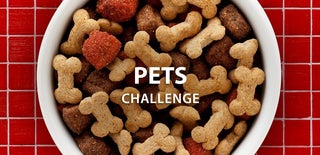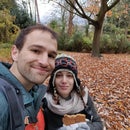Introduction: Flat-Pack Portable Dog Feeder
My wife and I love our dog, and we love having him with us when we visit our family and friends. Problem is, we have to carry so many things when we take him with us - his bowls, food, leash and even a mattress (he's a sighthound and its painful for them to sit on the floor). We have to bring so many things that they don't even fit in a single bag. So, to make things easier I made a flat-pack feeder that we can carry around with us. It's designed to be lightweight and portable rather than being super sturdy like some dog feeders are.
In this instructable I'll show you how to make your own flat-pack dog feeder just like mine.
I hope you like my instructable, and if you have any questions or comments, let me hear them all! I'll be happy to reply:)
Supplies
I made this using a laser cutter (xTool D1). If you don't have a laser cutter or a CNC of some sort, I hope you find some inspiration in my project even though it'll be hard to follow along!
You'll need:
- 3.5-4mm wood of your choice (about 36*50cm^2 or 14" by 20" in total).
- Glue (preferably food safe for the safety of your pet!).
- A thick and flexible plastic film or bag (to make the bowls, see below).
- Sticky-back plastic film.
- Strong magnets* (8 will do).
* Affiliate link means I might get a small commission if you use this link for no extra cost on your hand. This product was tested by me and I found it to be working properly.
Step 1: Cut Out the Wooden Parts
The DXF files are attached. Cut out 1 copy of the base, 2 copies of the legs, and 2 copies of the rings.
When cutting the base part, you'll end up with two discs that need to be removed. We have use for these too! I accidentally cut them and had to glue them back together (2nd image) :) It's kind of pretty actually, but it wasn't intentional!
After cutting the parts, clean any dust or char left on them.
Step 2: Making the Bowls - Part 1
Waterproof the bottom discs (the 2 discs that were cut out from the base of the feeder).
Cover the top part of the disc with the sticky-back film and cut any excess (see images). If you don't have a sticky-back plastic film, you can use epoxy resin or something similar. As long as it is water-proof and kind of food safe you'll be fine.
Make sure it's glued well, and add some extra glue if needed to make it last longer.
Step 3: Making the Bowls - Part 2
Now that we have the bottom face of the bowls, we need to make their curved faces, which is the tricky part.
- Cut two strips of plastic out of the plastic film. Each strip should be about 8cm wide by 48cm long (about 3" wide by 19" long.
- Apply some glue to the edge of the first disc (first image).
- Roll the plastic film around it and secure it with some scotch tape.
- The plastic film should have its two edges overlapping. Glue them together. Apply plenty of glue so it is water-tight. You can use a silicon-based sealant for this.
- At this point you should have something that looks like an open-ended cylinder. Add extra glue to the inner edges cylinder where the plastic film meets the wooden disc (third image). Keep adding glue all around so that it seals the bottom part of the cylinder (4th & 5th images).
Step 4: Attach the Bowls to the Base
The bowls are now ready, all we need to do is to attach them to the base of the feeder.
We want the bowls to be hanging slightly above the ground.
- Lay the on a book or something similar to raise them about 1cm (1/2") above your work table, insert the legs of the dog feeder into the base, and place it over the two bowls (first image).
The bowls should have some plastic film remainders sticking out. We're going to use that to permanently attach the bowls to the base.
- Use scissors to cut the part of the plastic film that is sticking out into many short tabs. Make sure the cuts don't reach below the upper plane of the base.
- Use glue to hold attach the plastic tabs to the wooden base (3rd image). Once glued, it should look something like what you see in the 4th image.
- Use a sharp knife to cut off any excess plastic (5th image).
- The large rings we cut out of wood will be used to secure this even stronger. Apply plenty of glue on them, and lay them over the plastic tabs, securing the bowls in place.
Step 5: Add Magnets
I decided to add magnets to the design so that everything stays nice and tidy when we carry it. I didn't place them inside the wood on purpose - I didn't want the design to have holes in it in case someone decides to skip this step, but more importantly, the magnets wouldn't be in close contact if they were flush with the wooden base/legs (see images for how it's packed).
- Mark the middle of the two outer edges of each of the legs (first image).
- Glue the magnets using a very strong glue (see result in second image). Wait for the glue to dry.
- While giving them a slight turn, squish the bowls so that they are flat (third image).
- Lay the leg on top of the bowls. They will later hold them in place. Mark where the magnet meets the wood.
- Glue a matching magnet to the base of the feeder. Make sure the polarity of the magnets attached to the base match the polarity of the magnets attached to the legs! You can do that by marking one side of all of your magnets with a sharpy before you start gluing them.
- Let the glue dry. The final result should look like what I show in picture #5.
Step 6: All Done!
You're all done! Here are some extra tips:
- When you pack the feeder, squish the bowls while giving them a slight rotation so that they pack nicely.
- Make sure everything is sealed before you take it out of the house for the first time! Creating sealed bowls is not trivial!
- Clean and dry the bowls after use so nothing grows on it over time.
- Unless you decide to use a thicker piece of wood, this design can carry about 700g (about 2 pounds) of food & water combined before getting deformed too badly. That's usually good enough for short visits, but if you have a large dog you may need to upgrade my design (let me know if you need help).
Thanks for reading!
If you like my instructable and want to see more, you're welcome
to visit my instructables page and my website
By the way, the best way to support my work is by subscribing to my new YouTube channel! :) Thank you!

Runner Up in the
Pets Challenge














